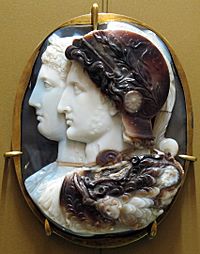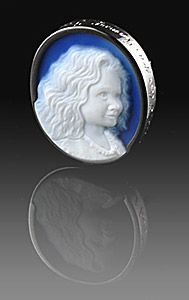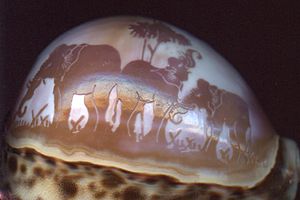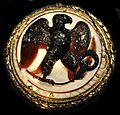Cameo (carving) facts for kids
A cameo is a special kind of carving that makes a raised picture. Think of it like a sculpture that sticks out from its background. This is different from an intaglio, which has a picture carved *into* the surface.
Originally, a cameo always had a picture in one color against a background of a different color. Artists made these by carefully carving materials that had two or more layers of different colors. They would remove the top layer to show the color underneath, creating a cool contrast.
Sometimes, artists would make a special type of cameo called a "cameo incrustation." They would carve a tiny portrait, make a mold from it, and then create a ceramic version. This ceramic piece was then put inside a glass object, like a paperweight. These were very hard to make but were popular from the late 1700s to the late 1800s.
Today, the word "cameo" can also mean other things. For example, a "cameo appearance" is a short role by a famous person in a movie. It can also mean a picture of a head in an oval frame, no matter what it's made from.
Contents
How are Cameos Made?
Ancient and old cameos were often made from special gemstones, like different types of onyx and agate. These are called "hardstone" cameos. They used stones that naturally had flat layers of different colors.
Today, cheaper cameos are often made from shells or glass. The Romans even made amazing glass cameo vessels, like the famous Portland Vase.
There are a few ways to make cameos:
- Assembled Cameos: A carved picture (like a portrait) is placed onto a background of a different color.
- Traditional Carving: This is harder! The artist carves directly into a material that already has different colored layers, like banded agate or layered glass. This way, the different colors are part of the same piece.
Sometimes, dyes are used to make these colors even brighter.
History of Cameos
Some people believe the word "Cameo" comes from an old word, "Kame'o," which meant a "magical square" or a kind of good luck charm with carvings on it.
Cameos are often worn as jewelry today. But in ancient times, they were mostly used for signet rings (rings with a design used to make a seal) or large earrings. The biggest ones were probably just art pieces to admire.
Amazing stone cameos were made in Greece as far back as the 5th century BC (over 2,500 years ago!). The Farnese Tazza (a cup) is one of the oldest and most important Greek cameos still around.
Cameos were very popular in Ancient Rome, especially with the family of Emperor Augustus. Famous Roman "state cameos" include the Gemma Augustea, the Gemma Claudia (made for Emperor Claudius), and the Great Cameo of France, which is the largest flat carved gem from ancient times. Roman cameos became less common around 300 AD, but people still made them, just not as many, through the Middle Ages.
The art of cameo carving has become popular again many times throughout history:
- In the early Renaissance (around the 1400s).
- Again in the 1700s and 1800s.
- The Neoclassical revival started in France with Napoleon's support. His coronation crown even had cameos!
- In Britain, King George III's granddaughter, Queen Victoria, loved cameos. They became so popular that they were mass-produced by the late 1800s.
The beauty of cameos has even inspired writers! The Russian poet Lev Mei wrote poems called Cameos in 1861, inspired by Roman rulers. In 1852, Théophile Gautier named his collection of polished poems Enamels and Cameos.
Roman Glass Cameos
During the Roman period, artists used the cameo technique on glass to copy the look of cameos made from agate or sardonyx. Roman glass cameos are very rare. Only about 200 pieces and 16 complete objects are known today.
Most early Roman glass cameos had a blue glass base with a white layer on top. Later ones usually had a clear background with a colored layer over it. The most famous example from the early period is the Portland Vase.
Shell Cameos
While shells were sometimes used in Roman cameos, they became much more popular for carving during the Renaissance (1400s and 1500s). Before that, most cameos were carved from hardstone. Renaissance shell cameos were usually white on a grayish background, carved from mussel or cowry shells.
In the mid-1700s, new types of shells arrived in Europe from the West Indies, like helmet shells and queen conch shells. This led to a huge increase in shell cameo carving. Conch shells are great for carving, but their color can fade over time.
After 1850, cameos became even more popular as souvenirs for middle-class travelers on the Grand Tour (a trip around Europe).
What Did Cameos Show?
In the past, cameos usually showed scenes from Greek or Roman mythology, or portraits of rulers and important people. Kings and queens often gave agate portrait cameos as gifts to their subjects. Many of these old cameos, some over 2,000 years old, are now in museums or private collections.
Famous Historic Cameos
- Gemma Augustea Cameo – Roman, after 10 AD. Made from two layers of onyx.
- "Tazza Farnese" – An ancient Greek bowl made from a very large cameo.
- Portland Vase – The most famous piece of cameo glass.
- Great Cameo of France – Roman, around 23 AD. Made from sardonyx.
- Gonzaga Cameo – Shows Ptolemy II and Arsinoë II. Made from sardonyx in the 3rd century BC.
- "The head of Flora Cameo" – Carved by Benedetto Pistrucci in 1812 AD. This cameo uses different layers to create the roses and the face.
Modern Cameos
Many modern cameos are carved into layered agates. The layers are often dyed to make the color differences stand out. Common colors for two-layer stones are white on black, white on blue, and white on red-brown. Sometimes, three-layer stones are made, usually black on white on black.
The layers are a bit see-through. This allows the artist to create shading effects by making the top layer thinner, letting the background color show through a little. This can make the figures look very realistic. For example, thinning a black top layer on a three-layer stone can make it look brown.
Machine-Carved Cameos
Most modern agate cameos are made using a machine called an Ultrasonic Mill. This machine can quickly make many copies of a design. A master design is pressed onto the agate blank, and a special diamond paste helps with the cutting. The machine vibrates very fast to carve the cameo. The original master design is often carved by a skilled artist.
Cameos made this way often have a smooth, matte surface. Experts can tell they are machine-made by this texture and by the way the carving is done.
Hand-Carved Portrait Cameos
These cameos are carved by hand, often from photographs of a person. Since only one copy is usually made, it's not worth using the machine carving process.
Very few people do this kind of work. It's one of the hardest things for a gemstone carver to do! It takes a lot of artistic talent, skill, and years of practice to create lifelike portraits.
Today, it's rare to find hand-carved agate cameos that aren't portraits. Traditional scenes from mythology or standard images of young ladies are more likely to be made with the help of the ultrasonic carving machine in limited collections.
Shell Cameos
Since the late 1800s, the best quality shell cameos have often been made from the Cypraecassis rufa, also known as the bullmouth helmet shell. This shell can be up to 6 inches long. It has a whitish top layer and a rich orange-brown bottom layer. These shells come from places like Madagascar and South Africa. The best hand-carving of these shells happens in Italy.
The most valuable shell for carving is the emperor or queen's helmet shell, Cassis madagascariensis. This shell has white and dark brown layers, and it looks similar to the layered agate called sardonyx. This shell is found in the waters of the Caribbean.
The world center for shell cameo carving is Torre del Greco, Italy. First, the shells are marked with oval shapes. Then, they are cut into oval blanks for the carver. The actual cameo is mostly cut with a metal tool called a bulino. Other metal tools are also used. Grinding wheels help remove extra material quickly. Once the details are finished, the shell is soaked in olive oil, cleaned, and polished.
Images for kids
-
Cameo of Roman Emperor Augustus wearing a gorgoneion and a sword-belt. Three-layered sardonyx cameo, Roman artwork, ca. 14-20 AD.
See also
 In Spanish: Camafeo para niños
In Spanish: Camafeo para niños
- Cross of Lothair – This cross has a three-layered cameo of the Roman Emperor Augustus in its center.
- Jasperware – A type of ceramic that looks like cameos.








